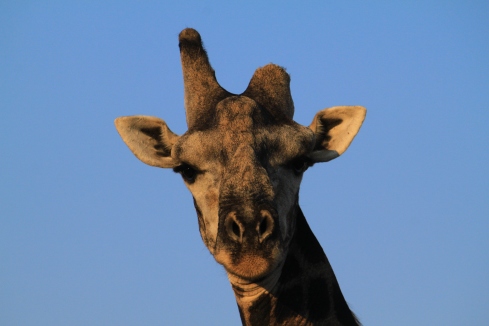Just a quick little video impression of the roadtrips that we did around Pucón…
https://vimeo.com/324834185
Best viewed after reading the previous story, by the way!!
Just a quick little video impression of the roadtrips that we did around Pucón…
https://vimeo.com/324834185
Best viewed after reading the previous story, by the way!!
Come December more European or American kayakers show up at the hostel. Having paddled the Lower Trancura maybe 25-30 times by now, I am definitely ready for a change, so I team up with Rodolfo (my hostel’s owner) and a group of rowdy American kayakers to paddle the Upper Palguin, a very short section of only 500 metres that consists of only three major drops/waterfalls. But with the put-in and take-out being so near to each other, most people do multiple laps in a row.
Not me though. Lacking the conviction that I can pull off the crucial move on the first double drop, and it scares the shit out of me. I decide to walk that one. The second (4 metre) and third drop (6 metre) are not really walkable though and I make it down although the way I do lacks any sense of style. I don’t really care though. These are the first big(ger) drops that I’ve run after the 22 Saltos experience, so I consider not losing my boat a definite win.
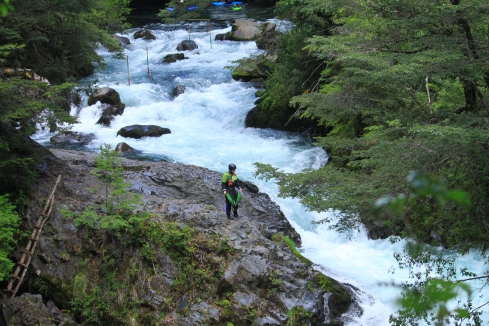 Some days later I join Oli, Alex and Chito who are invited a two-day rafting trip on the río San Pedro organised by Ben May, who coincidentally wrote the guidebook on Chilean rivers. It’s a tranquil, but lovely and scenic river with the occasional rapid. But mostly it’s just playing in whirlpools or having a beer at the beach. Good times.
Some days later I join Oli, Alex and Chito who are invited a two-day rafting trip on the río San Pedro organised by Ben May, who coincidentally wrote the guidebook on Chilean rivers. It’s a tranquil, but lovely and scenic river with the occasional rapid. But mostly it’s just playing in whirlpools or having a beer at the beach. Good times.
Being so close to río Fuy, we decide to paddle this one too. In the books described as a class III but with the water level now, the first part of the section is definitely a good class IV now. Definitely made my heart race and even skip a few beats, but even more so it’s an absolutely stunning river.
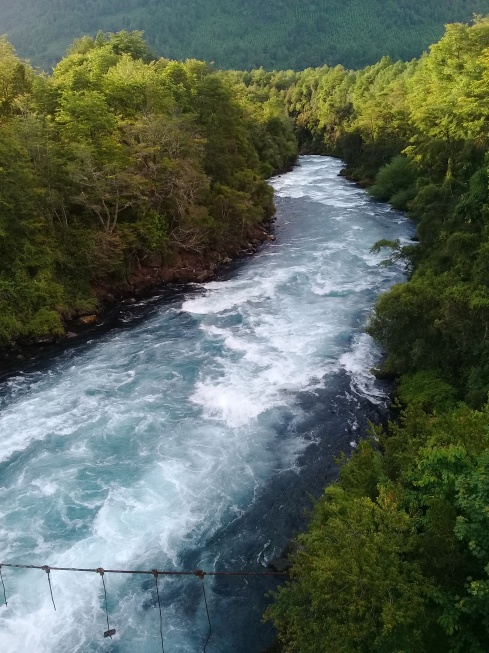
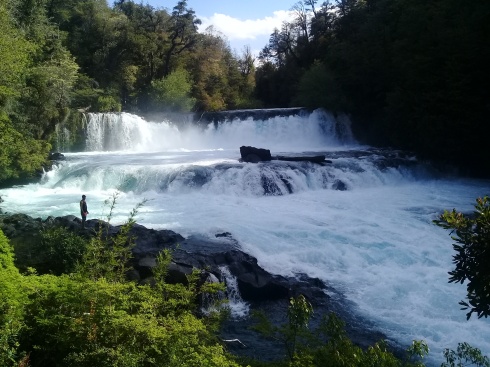 Then Oli, Alex and I head off to the north where the guys want to run some waterfalls. We end up at the 10 metre high Blanco Sur. I try to talk myself into running it, but somehow I cannot convince my mind of the sanity of it. It takes me a full night of semi-sleep, waking up numerous times, visualising the lines and moves I have to make. It helps, the next morning I actually feel ready. This doesn’t mean I’m not nervous, but once I get on the river just above the waterfall, I calm down and get into the zone.
Then Oli, Alex and I head off to the north where the guys want to run some waterfalls. We end up at the 10 metre high Blanco Sur. I try to talk myself into running it, but somehow I cannot convince my mind of the sanity of it. It takes me a full night of semi-sleep, waking up numerous times, visualising the lines and moves I have to make. It helps, the next morning I actually feel ready. This doesn’t mean I’m not nervous, but once I get on the river just above the waterfall, I calm down and get into the zone.
It turns out to be the perfect waterfall, as people had predicted. Easy approach, perfect lip, soft landing. It’s amazing. But still… when minutes later I’m by myself in the pool below, with the boys running back up for another lap, I can’t help but feel that the excitement I feel is only barely higher than the stress I experienced.
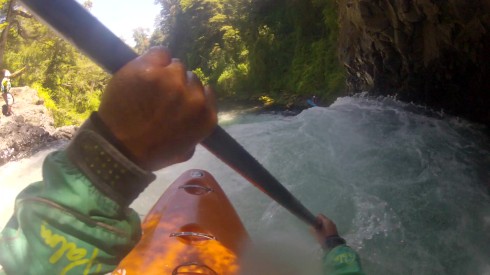 So I definitely choose not to run 15 metre high Tomatita waterfall. Only Oli runs it, even though you can tell he’s not really feeling it. In the end, he swims after not being able to roll back up. But not much lost. On we go!
So I definitely choose not to run 15 metre high Tomatita waterfall. Only Oli runs it, even though you can tell he’s not really feeling it. In the end, he swims after not being able to roll back up. But not much lost. On we go!
We head to Truful, an absolutely beautiful, continuous class III, river. It starts in an impressive canyon next to the Parque National Conguillío, with snowcapped volcan Llaìma towering above us. It’s only now that I realise I’ve been here before, when I had just arrived in Chile and on my way to Pucón. It shows how well prepared I was back then (and probably still am), since I never realised these rivers and waterfalls could be paddled.
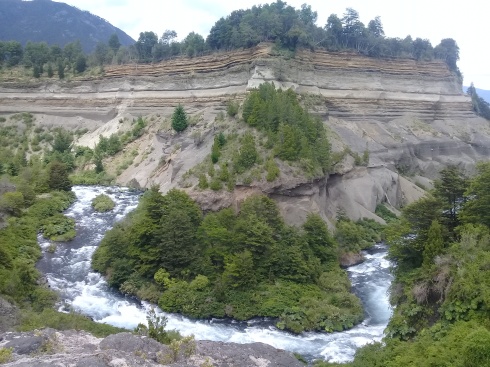 Back in Pucón, Alex is “meeting up” with a girl he met during Puesco fest, so we won’t be seeing him for a couple of days. Oli and I, however, meet a group of Norwegian kayakers, who are basically planning to do the exact same thing we just did, and decide to team up with them. Just because we can.
Back in Pucón, Alex is “meeting up” with a girl he met during Puesco fest, so we won’t be seeing him for a couple of days. Oli and I, however, meet a group of Norwegian kayakers, who are basically planning to do the exact same thing we just did, and decide to team up with them. Just because we can.
So we run Blanco Sur again, this time with wayyyy less stress, then head to Tomatito to see the guys run that with style, and then to Truful. Being young, avid paddlers the boys have a long hard look at the Truful cascades, but eventually decide not to run it.
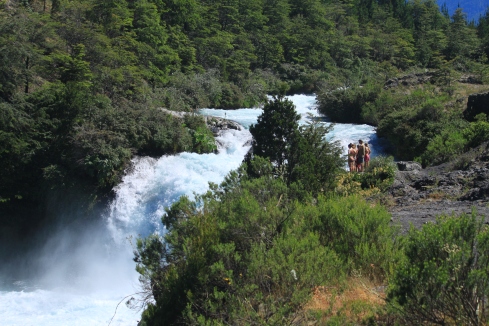 All of us then meet up with some British kayakers to paddle the río Llizan. This river is new to me and proves to be a proper class IV creek, and it is simply too difficult for me. Most of us portage the canyon at the beginning, but then the next two rapids are where I reach my mental limit. I can’t do this anymore. I am so fucking scared. It takes all the fun, and drains my energy, leaving me a mental wreck constantly on the verge of a mental breakdown.
All of us then meet up with some British kayakers to paddle the río Llizan. This river is new to me and proves to be a proper class IV creek, and it is simply too difficult for me. Most of us portage the canyon at the beginning, but then the next two rapids are where I reach my mental limit. I can’t do this anymore. I am so fucking scared. It takes all the fun, and drains my energy, leaving me a mental wreck constantly on the verge of a mental breakdown.
It’s crazy how I’ve been pushing my limits for weeks now. And I’ve probably been more scared, really scared, in the recent weeks than in the past 10 years. Up until now, I’ve been able to persevere, to find that what I thought was my limit, actually wasn’t. But I can’t do it anymore. I simply can’t. I was scared at the Palguin, then I was even more scared at Blanco Sur and now I’m even more scared here. It’s too much. I don’t need any of this. I’m too old for this stuff.
So I climb out of my kayak, sit down by myself for maybe half an hour as the others continue downriver, and then walk back to the road. I’m done. I need some nice, easy kayaking again. Stressfree and fun.
We get a well-earned dose of fun at our wild camp that evening. It’s John’s birthday today, so we hang a kayak up in a tree, cover it in alumium foil and add a couple of lights. It’s the kayakers version of a disco ball. And let’s be honest: no real party without a disco ball.
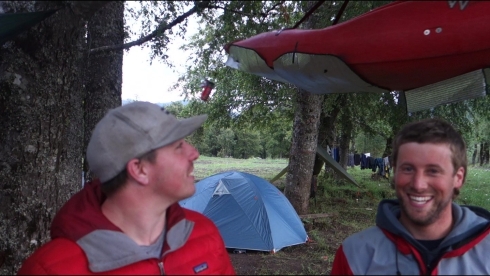
We light up a nice little fire, drink some wine, and play loud 80’s music (which is apparently quite popular in Norway). It is so cool to have about six nationalities come together and unite in simple, but universal fun.
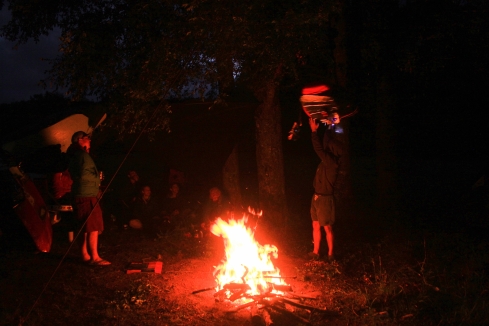 Generally this and a disco kayak should have been enough to make John’s birthday unforgettable, but it’s around midnight that his birthday reaches the status of “epic”. While were all dancing under the disco kayak to the tunes of Sister Sledge – He’s The Greatest Dancer (which applies to none of us), we’re suddenly startled an approaching police car flashing it’s lights. Apparently, we’re trespassing, making a fire and drinking in public… all of which is illegal in Chile.
Generally this and a disco kayak should have been enough to make John’s birthday unforgettable, but it’s around midnight that his birthday reaches the status of “epic”. While were all dancing under the disco kayak to the tunes of Sister Sledge – He’s The Greatest Dancer (which applies to none of us), we’re suddenly startled an approaching police car flashing it’s lights. Apparently, we’re trespassing, making a fire and drinking in public… all of which is illegal in Chile.
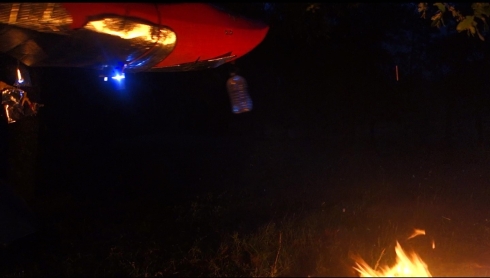 With me being the only one speaking proper Spanish, I am unvoluntarily chosen to be spokesperson of the group (I know it’s probably not the right moment for it, but I feel somewhat proud of that, thinking about how far I’ve come with my Spanish). So while we hand in our passports, I explain to the officers what is going on, that it’s John’s birthday and that we meant no harm. John helps me out by speaking the only sentence he remembers from Spanish class he had in highschool: yo tengo mi cumpleaños el diez y nueve de diciembre. I stay away from trying to elaborate on the disco kayak though. I figure it speaks for itself.
With me being the only one speaking proper Spanish, I am unvoluntarily chosen to be spokesperson of the group (I know it’s probably not the right moment for it, but I feel somewhat proud of that, thinking about how far I’ve come with my Spanish). So while we hand in our passports, I explain to the officers what is going on, that it’s John’s birthday and that we meant no harm. John helps me out by speaking the only sentence he remembers from Spanish class he had in highschool: yo tengo mi cumpleaños el diez y nueve de diciembre. I stay away from trying to elaborate on the disco kayak though. I figure it speaks for itself.
At first the police explains that we will have to leave and go to an official camp site. They will even escort us there. When we point out that all of us are intoxicated beyond the legal limits and rather unfit to drive, they simply shrug and tell us not to worry about that. After all, they will be escorting us.
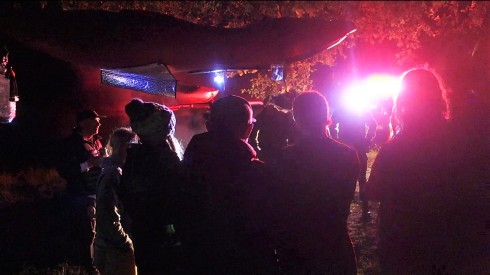 So with a free pass to drink and drive, they make us pack our stuff. I’ve noticed one of the police officers is barely able to keep a straight face, and sense that they think we’re kinda funny. Obviously, 12 drunk people gathering their stuff and taking down their tents, tarps and hammocks is a slow proces and after a couple of minutes I’m told that we should hold: the police is going to see the land owner and enquire whether it’s okay if we stay there for the night. Ten minutes later they return and we’re given the thumbs up: we can stay. But only for one night! So we extensively thank the police, giving them sincere abrazos and even kisses by some of the girls. Must be a good night for them as well.
So with a free pass to drink and drive, they make us pack our stuff. I’ve noticed one of the police officers is barely able to keep a straight face, and sense that they think we’re kinda funny. Obviously, 12 drunk people gathering their stuff and taking down their tents, tarps and hammocks is a slow proces and after a couple of minutes I’m told that we should hold: the police is going to see the land owner and enquire whether it’s okay if we stay there for the night. Ten minutes later they return and we’re given the thumbs up: we can stay. But only for one night! So we extensively thank the police, giving them sincere abrazos and even kisses by some of the girls. Must be a good night for them as well.
Having not saìd anything about the music, we once agaìn turn up the base and party well into the night…
The next morning I’m still hoping for some stressfree paddling, but that’s not what I get even though we head back to the río Fuy again. To my surprise the plan is to do another section of the river this time. Once again being the lesser kayaker of the group, I am somewhat concerned about what I’m getting myself and for a brief moment I contemplate not joining the group, and putting in at the lower section. But then I figure, no guts no glory and I join them anyway.
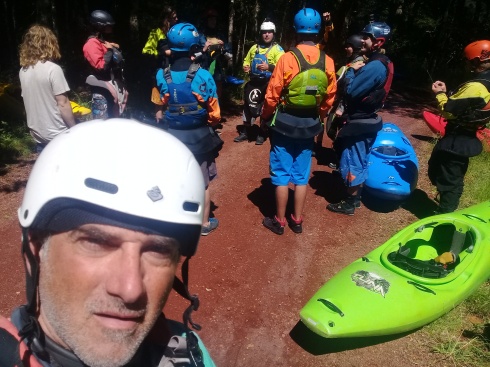 What follows is probably one of the most exciting sections I’ve paddled here in Chile. Really fun continuous class IV water, although the fun part is probably the result of the adrenaline rushing through my veins. For me this is definitely survival paddling: I’m surviving but not really in control of what I do. And I’m super happy to see the bridge that indicates the start of the easier section that I’ve already paddled before.
What follows is probably one of the most exciting sections I’ve paddled here in Chile. Really fun continuous class IV water, although the fun part is probably the result of the adrenaline rushing through my veins. For me this is definitely survival paddling: I’m surviving but not really in control of what I do. And I’m super happy to see the bridge that indicates the start of the easier section that I’ve already paddled before.
We return to Pucón for a couple of days of well-deserved chill time. But now we run into German kayakers Rocco, Sebastian and Peter who are keen to paddle. So once again we set off. To río Puesco (which I do not run), to Upper Palguin (which I do run now), and to río Fuy once more. Admittedly, I spend alot of time faffing and playing pingpong as well, but man, this is so cool!!All in all, these weeks have been quite epic. I got to paddle so many rivers, met so many cool people, had so many laughs, drank so many cheap beers and ate way too much ice cream. I really don’t think life could get any better!
When we get back to Pucón I suddenly realise all of this has in some way been the result of reading that kayak magazine years ago. And so I make a promise to myself, call it a New Year’s resolution: when I get back to Holland I will spend more time reading… preferably on the toilet.
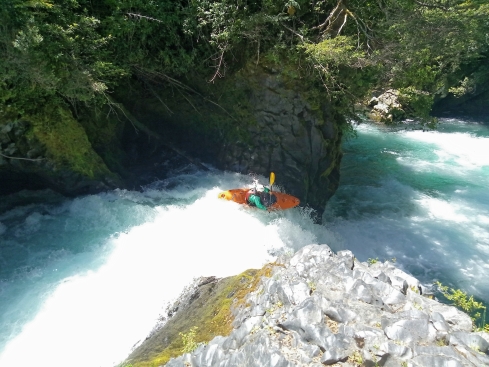
The only time I read a kayak magazine was when I got it for free after purchasing a decent amount of goods online. The magazine lay there, on my dining table, for months probably, untouched. Until at some point I moved it to the toilet, and I started reading it.
One of the stories was about the early days, when kayakers were only discovering the vast amount of rivers Chile had to offer. Some pioneering kayakers moved to Pucón to explore and by doing that, they opened up an area that has now become a mecca for kayakers, with multiple challenging rivers within day trip distance. After my short visit earlier this year, I envision staying in Pucón for a couple of months. Let’s see what the fuss is about.
The weather gods aren’t very welcoming to me during my first week in Pucón as it rains every day. For the most part I’m the only person staying at the campsite. It takes me a few days to get in touch with some paddlers, but when I do, it immediately works out great. Local kayaker and raft guide Patricio is willing to take me to the río Trancura and show me the lines. It’s an amazing river, especially now that the water level is high. The lower section is a bit short however, but we solve that by doing two or three laps a day. It’s a great river for me to practice and improve my skills while not completely pushing my limits. I’m actually being very thoughtful about this now. I’m taking it one step at a time, aiming to move forward, but at my own pace, focusing on technique rather than adrenaline.
After a couple of days Patricio joins me when I team up with another group of kayakers who have invited me to paddle the río Zahuil. It’s a good thing I brought Pato with me, since the guy who invited me, never actually talks to me. It is one of the strangest thing ever..
But whatever, we’re a big group of 12 kayakers so plenty of other people to interact with, and the river is a fun class III river run. So all in all definitely worth going.
 After a week on the empty camp site I move into Étnico eco hostel in town where I get a pretty sweet deal on accommodation that saves me from having to spend more rainy nights in the back of my car. Having travelled a lot during the first six months in South America I’m super keen on doing it differently this second half, and during the first weeks I don’t move much further than the Lower Trancura, slowly settling into a routine, while making new friends along the way.
After a week on the empty camp site I move into Étnico eco hostel in town where I get a pretty sweet deal on accommodation that saves me from having to spend more rainy nights in the back of my car. Having travelled a lot during the first six months in South America I’m super keen on doing it differently this second half, and during the first weeks I don’t move much further than the Lower Trancura, slowly settling into a routine, while making new friends along the way.
As the weather steadily improves to sunshine-only conditions, Romi and Basti join and their friends join Pato and me on an almost daily basis, as they are training to be hydrospeed guides and exams are up in a month or so. I also meet Guillermo, an amazing paddler who has a Dutch girlfriend from Limburg. He gives me his last stroopwafel, which immediately makes us friends for life.
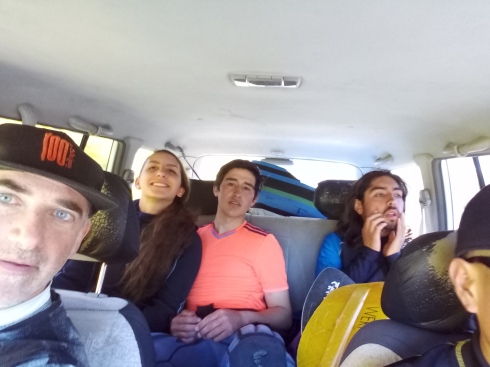 I enjoy slowly becoming part of the Pucón kayak scene. It feels good to have a base and not move every so many days. And even though there’s no denying that there is a tremendous age-gap between and my generally much younger friends, I love tapping into the limitless energy that comes with their age. I love being surrounded by these young kids. Aways restless and sometimes reckless, full of energy, and enthusiasm for just about anything.. I love it. Some people my age pretend they still have that, you’ll hear them say You’re only as old, as you feel or Age is just a number, but that level of enthusiasm and/or recklessness is something I’ve definititely lost.
I enjoy slowly becoming part of the Pucón kayak scene. It feels good to have a base and not move every so many days. And even though there’s no denying that there is a tremendous age-gap between and my generally much younger friends, I love tapping into the limitless energy that comes with their age. I love being surrounded by these young kids. Aways restless and sometimes reckless, full of energy, and enthusiasm for just about anything.. I love it. Some people my age pretend they still have that, you’ll hear them say You’re only as old, as you feel or Age is just a number, but that level of enthusiasm and/or recklessness is something I’ve definititely lost.
 Simultaneously, however, I feel the need to set my own limits to stay within my own comfort level. So even when they are trying to get me to paddle harder rivers, I stick to the Lower Trancura as it is a perfect training ground for me.
Simultaneously, however, I feel the need to set my own limits to stay within my own comfort level. So even when they are trying to get me to paddle harder rivers, I stick to the Lower Trancura as it is a perfect training ground for me.
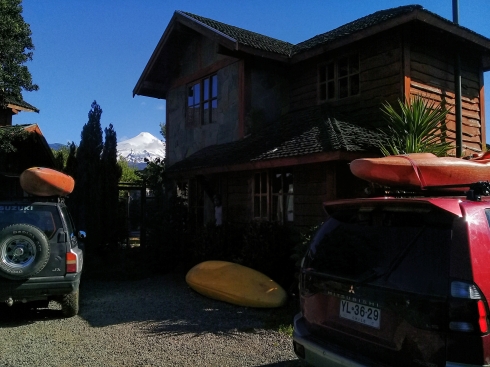
While saying goodbye to the Frenchies and Noé in the parking lot of Siete Tazas, we meet three other kayakers. As the others take off, Noé tells me to definitely talk to them as he is sure one of the guys is a well known kayaker.
So I chat a little with them, but nothing says “famous” to me. Even when they tell me they will be running the 25 metre high Salto Leona at the end of Siete Tazas canyon I’m somewhat sceptical. I would like to see them do it, but at the same time I have no desire to see someone plunge to their death.
As the guys go scout their route, I chat some more with the photographer of the group. He works for Pucón kayak hostel, and I figure he might be a good contact to have. I decide go to the bottom of the waterfall with him, where he hands me a camera to take pictures of the guys running the waterfall.
He then explains these three guys are some of the best extreme kayakers in the world. Their names don’t ring a bell at all though, but admittedly I don’t really watch kayak videos nor do I read kayak magazines.
It takes about two hours sitting still before Adrian, Evan and Hayden (who’s turning only 18 years old today) appear from the obscure canyon and drop into the pool below, where unsuspecting tourists are just swimming and relaxing.
In exchange for me taking their pictures, the guys offer to pay me dinner, and it’s only then, when they show me their gopro footage, that I realise how good these guys are. It’s not just the 25 metre drop, but the part before the waterfall that is supersketchy.
Admittedly, I don’t really fit into this group and it’s hard to relate to these guys as they only talk about the wildest, biggest, most infamous rivers and highest waterfalls on the planet. On the other, hand, they actually heard of this guy almost losing his boat on 22 saltos the other day, so I guess I have a small claim to fame as well.
It does become clear to me though that these guys are not simply daredevils taking on huge risks that mere mortals like me will never be willing to take. These are some of the most capable kayakers in the world, aiming to push the limits of the sport, not just for their own glory but for the progression of the sport.
Unfortunately for me, they are taking it to way too far…
It’s the last week of October when I leave my beloved Africa behind and fly back to my second-favourite continent. I’m back in Chile baby!!
The fun immediately kicks off, as I’m meeting up with Blaise and his friends to go on a week-long kayak roadtrip. But first I need to fix my car.
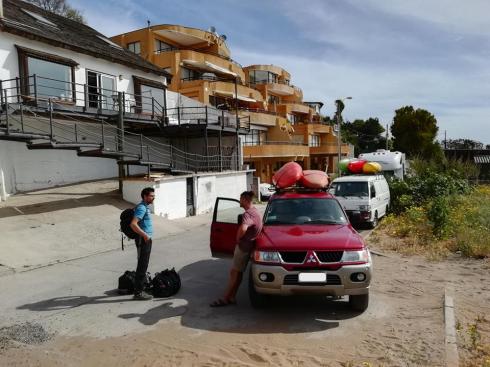 Upon arrival it has a dead battery, a flat tire and the handbrake is rusted up. The battery and tire are an easy fix, but the brakes are more difficult. I spend a couple hours trying to fix it, then figure I should just try to drive off in 4×4 low gear. It works wonders. We’re good to go… although.. wait.. on my first little test drive I find out -mid corner- that the car doesn’t idle anymore and basically dies when running stationary. Maybe doesn’t sound too bad, until you realise that if the engine dies, power steering and brake assistance also stop working, which is all but convenient in mid-corner.
Upon arrival it has a dead battery, a flat tire and the handbrake is rusted up. The battery and tire are an easy fix, but the brakes are more difficult. I spend a couple hours trying to fix it, then figure I should just try to drive off in 4×4 low gear. It works wonders. We’re good to go… although.. wait.. on my first little test drive I find out -mid corner- that the car doesn’t idle anymore and basically dies when running stationary. Maybe doesn’t sound too bad, until you realise that if the engine dies, power steering and brake assistance also stop working, which is all but convenient in mid-corner.
Briefly I consider going to a mechanic which would probably mean missing out on a couple of paddling days. But setting my priorities straight I decide my best option is to simply not accept the existence of any problem. Besides, turning on the airconditioning raises the idle rpm just enough for the engine not to stall anymore. Non-existent problem solved!
First stop is the río Teno, where we get a warm welcome by Felipe who runs the small tourism office. It’s still low season so he isn’t too busy and even offers to run shuttle for us in exchange for a pizza.

The rivers is a nice starter, although I can’t deny I’m a little bit rusty. Even the Zambezi didn’t change that. Thanks to Felipe’s help we even manage to do a lap on the nearby río Blanco which proves to be a nice and easy stress-free river with some really clear water.
Then Felipe generously offers us to stay in his house for the night. It’s perfect for us, since Nico and Noé cannot sleep in a car, and now don’t have to bother with setting up a tent. In the morning Felipe even makes home made bread.. it’s delicious!
 It’s tempting to stay longer, but other rivers are waiting. Unfortunately, given the amounts of rain during the last couple of days, the Achibueno is bursting its banks and has basically become unrunnable for mere mortals like us. So we continu further south to río Ñuble.
It’s tempting to stay longer, but other rivers are waiting. Unfortunately, given the amounts of rain during the last couple of days, the Achibueno is bursting its banks and has basically become unrunnable for mere mortals like us. So we continu further south to río Ñuble.
We’re told that the Ñuble also has high water now (apparently 3 times the usual flow) but at least it’s still runnable if not a bit flattened out. Still a few big waves but mostly just a very wide river. Still fun though.
We have some difficulty finding an adequate camping spot for the night, but a local farmer tells us we can set up our tents on his grassy patch next to the river. Just don’t mind the goats and sheep that will be passing by every now and then.

While having fun in the rivers, Noé and I are getting rather frustrated with the Frenchness of the French. The common language amongst the five of us is English, but Blaise, Nico and Flore are constantly speaking French, basically keeping me and Noé out of their conversations.
After another run on a more upper stretch of the Ñuble we head to Siete Tazas, a national park that is home to a river with the perfect beginner waterfalls. As in, a perfect place for kayakers to learn how to run waterfalls.
Unfortunately we are greeted by more rain and the next day we’re forced into hiding in the car. Or well, that was me at least. The others go for walks, I just stay in and around the car, practicing some drawing, a new hobby I picked up recently.

 We head back to Siete Tazas the next morning and then something happens.. to this day I don’t really know what. Somehow we end up doing a different stretch of river than originally planned. We end up climbing down into a canyon just above a 2 metre drop.. after we run it, we are committed: only one way out now, and that exit is downriver.
We head back to Siete Tazas the next morning and then something happens.. to this day I don’t really know what. Somehow we end up doing a different stretch of river than originally planned. We end up climbing down into a canyon just above a 2 metre drop.. after we run it, we are committed: only one way out now, and that exit is downriver.
This section is definitely not the perfect place to learn how to run waterfalls. One should definitely have some experience with waterfalls, which most of us do not. But we all start off pretty well, manage to do an 8 metre high drop without problems.. so who cares really??
 I start to care a little bit when I mess up a very narrow stretch where the canyon is barely more than 1 metre wide. I flip on the entry, and with rolling up not an option I fear getting stuck with the kayak. So I decide to swim. One of my shoes gets stuck in the boat however, so still I get to do this crux section under water. Luckily, I don’t get hurt, but the reality that we are somewhat in over our heads is starting to dawn on me.
I start to care a little bit when I mess up a very narrow stretch where the canyon is barely more than 1 metre wide. I flip on the entry, and with rolling up not an option I fear getting stuck with the kayak. So I decide to swim. One of my shoes gets stuck in the boat however, so still I get to do this crux section under water. Luckily, I don’t get hurt, but the reality that we are somewhat in over our heads is starting to dawn on me.
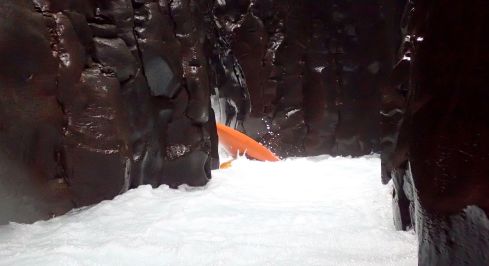 As we get to another waterfall, it turns out to be a double drop, a 2 metre drop right after a 3 metre drop. Although it is essential to nail the first drop, instructions for me somehow get lost in translation, and I go off it aiming to the right where I should have been aiming to the left. It lands me in very boily water, that slows me down dramatically and I go down the second drop without speed. When I land I still think I’ve made it, but then the current pulls me back into the waterfalls and pushes me under. I try to get out but somehow I do not resurface. Even after I exit the kayak I’m being held down by the water.
As we get to another waterfall, it turns out to be a double drop, a 2 metre drop right after a 3 metre drop. Although it is essential to nail the first drop, instructions for me somehow get lost in translation, and I go off it aiming to the right where I should have been aiming to the left. It lands me in very boily water, that slows me down dramatically and I go down the second drop without speed. When I land I still think I’ve made it, but then the current pulls me back into the waterfalls and pushes me under. I try to get out but somehow I do not resurface. Even after I exit the kayak I’m being held down by the water.
This is the first time this has ever happened to me, and it’s fucking scary. Being non-aquatic and a mammal, I kinda need my oxigen, but seconds pass without me resurfacing. For a split second the ominous thought of “man, this is how it ends” shoots through my mind but then I feel rocks under my feet, push off as hard as I can and a second or two later breath in air again. Man, that was fucking scary!!
My kayak however doesn’t come out of the recirculating water, and with us being in an overhanging canyon there’s no other option then for me to swim the remaining part of the section.
As it turns out, the double drop is the last real drop of the section and the canyon soon opens up enough for me to climb out and walk back to camp. Man, for something to go this wrong, it couldn’t have happened in a better spot. I really would not have liked having to swim another 5 or 6 metre high waterfall!!!
 That night everyone except me is elated. We meet some American kayakers in the camp site and we share some of our ordeal (in total we had 6 swims). Yeah man, we did 22 saltos, as the section is apparently known. Ow yeah!! Not only are they completely oblivious to the fact that I just lost my kayak an hour ago, but all of a sudden the Frenchies have mysteriously mastered the art of speaking English. It fucking pisses me off and it sends me into a rant about how freaking idiotic this day has been, and how incredibly dumb it is to celebrate a day where we were in way over our heads. My rant is met with silence.
That night everyone except me is elated. We meet some American kayakers in the camp site and we share some of our ordeal (in total we had 6 swims). Yeah man, we did 22 saltos, as the section is apparently known. Ow yeah!! Not only are they completely oblivious to the fact that I just lost my kayak an hour ago, but all of a sudden the Frenchies have mysteriously mastered the art of speaking English. It fucking pisses me off and it sends me into a rant about how freaking idiotic this day has been, and how incredibly dumb it is to celebrate a day where we were in way over our heads. My rant is met with silence.
First thing I do the next morning is walk to the river. It rained the whole night, and the water level is way up compared to yesterday. I have some hope the kayak may have flushed. At first no sign of it though. I keep clambering upriver and just as I’m about to give up, I see my big orange kayak floating upside down in an eddie… I rush over, take off my pants, almost jump in the water but realise it’s rather cold and don’t want to get wet.. And then wait until it floats close so I can get it without getting too wet. Oh, my precious! Reunited!!! One of the Frenchies says something like you see, it wasn’t bad after all. I resist the urge to go into another tirade.
With the river being too high now, we need to change plans. There’s been lots of rain all over the region, so most rivers will be no option for us. We decide to go back to río Teno, where we once again get to stay with Felipe. This time, instead of pizza, we have an asado at his place. It is so wonderful that he welcomes us into his home and as a thank you I try my utmost to talk to him and his wife, even though my Spanish has definitely taken a turn for the worse after three months without practice. The Frenchies will do no such thing though.. they even continue speaking French while we’re invited to spend the night in his house. It’s so French.
It definitely affects the mood I’m in, and when we get to the Achibueno for a second try, I don’t really feel like paddling. Which, honestly, is not that unconvenient, as it is not the easiest river for me. Halfway down the first stretch I decide to not continue. I’m simply not comfortable and I don’t want to swim the rocky rapids. It’s the first time -ever, I think- that I walked away from a river. Either I’m getting scared, or I’m getting wise.. I’m guessing scared..
We close off our paddle week by giving the real Siete Tazas a second chance. We climb down to the river entry and upon seeing the first drop, I immediately decide I’m not doing it. It simply looks too difficult for me. It takes me a while to realise the others share my reservations and we end up not running it. It’s a bit of a disappointment, but for a first week back in Chile I’ve kinda had enough excitement!
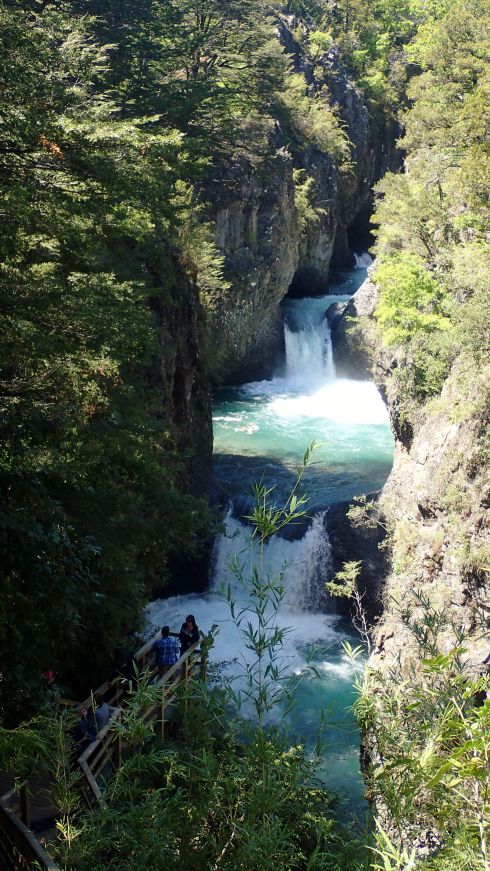
This feeling of pure elation temporarily vanishes as I enter South Africa two days later. Off course, this being Africa, there are no proper lines at the immigration office, but it works on a shove-hardest-served-first basis. Some guys are asking weird questions, and I notice some dude pushing into me, but I don’t realise he’s taking my phone out of my pocket. Fucking bastard… it is so South Africa! Not even have I set foot in the country and my stuff is already stolen. Fuck that shit.
I don’t really have time though to deal with it properly though. I’ve already made reservations for car rental and camp sites in Kruger Park for the next couple of days. So I head to the nearest shopping center to buy a new phone, then to a nearby Decathlon for some cheap camping gear and then try to make to Kruger the next day.
Right from the start, I feel perfectly at home in the park. This time there’s no pressure, no difficult questions, no annoying instructor, no lectures… Just me and the African nature. And it feels really good.
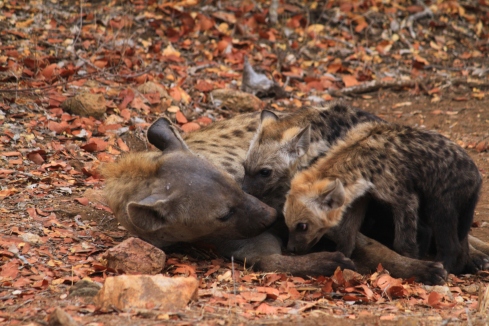
And suddenly I realise how much I’ve learned during the course. I see waterbuck and think you drink 15 ltrs per 100 kgs of body weight per day.. and even more on a hot day..
I see a giraf and link it to NASA’s design of its space suits. Zebra will forever be associated with farting and when I see kudu I’m reminded of Zulu folklore storytelling used to teach children that fighting is futile.
The first morning starts off with a skittish bushbuck, a waterbuck and a journey of giraffes at a nearby picnic spot. It’s a promising start but for the next hour the animals aren’t too enthusiastic in showing themselves. Luckily I have newfound skills now, and it’s super fun to hear this many familiar (bird) sounds and to have a picture in my mind of what I’m hearing.
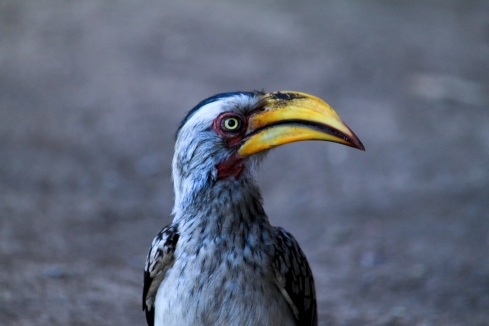
Seated at a little lake I recognise a male African jacana in mid flight, know chinspot batis, giant kingfisher and striated heron by their calls and identify yellow billed stork and African darter from 100mtrs distance. There’s one bird I don’t immediately recognise though and I’m tempted to run to the car to get my bird book… Luckily I manage to resist the urge. I decide I don’t want to be that much of a nerd.
It’s a futile attempt though, as I can’t prevent the newborn nature nerd in me from coming out. It happens especially whenever I see new animals, animals that weren’t present in Zimbabwe.
I see a steenbok and think what are you?
Then I see a grey duiker and think what are YOU??!
Then I see a Sharpe’s grysbok and think WHAT ARE YOU??!!??
Each time I grab my mammal book to read about these fascinating creatures.
At some point I’m staring in awe at three cute little klipspringers. And since I’m parked on the side of a gravel road, other cars stop as well, hoping for a spectacular sighting. I try to not make eye contact with them, since I’m only greeted with a mixture of utter disappointment, disdain, anger and disgust when they find out it’s not a lion or leopard but three klipspringers I’m looking at. If they only knew about their rumoured incestuous behaviour, they would surely find them more interesting… (or not, of course)
At another hide the first thing I notice are the terrapins resting and baking in the sun. Then three more beautiful little klipspringers catch my eye. I rejoice! Only after staring at them for several minutes do I notice the herd of elephant swimming across the river below. Dammit.. I’m turning into a David.
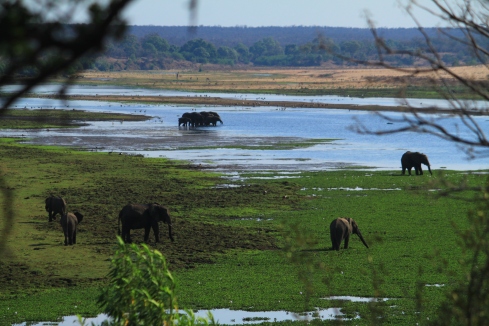
It gets even more bizarre at a leopard sighting. There’s a leopard hiding in a tree.. but I notice some birds making a lot of noise and flying around frantically. It’s typical mobbing behaviour, so I take my binoculars and catch a glimp of a boomslang climbing down the tree. Clearly the birds won this little battle. A car stops next to me and the driver asks me what I’m looking at. I’m rather proud of my situational awareness but nevertheless opt to only mention the leopard.
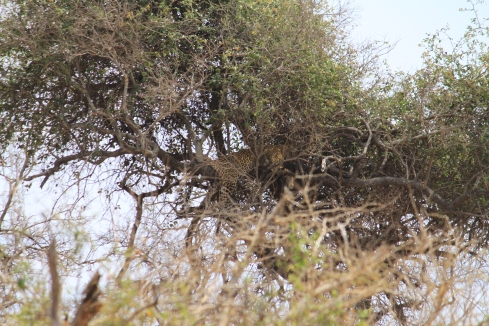
It’s definitely clear that I’m not a fully experienced guide yet though. For example, when I stop at a sighting of a fierce male lion it takes another 10 minutes for me to see the other male resting some 5 meters behind him. Then another 15 minutes to notice the three females and other male right next to the second male.
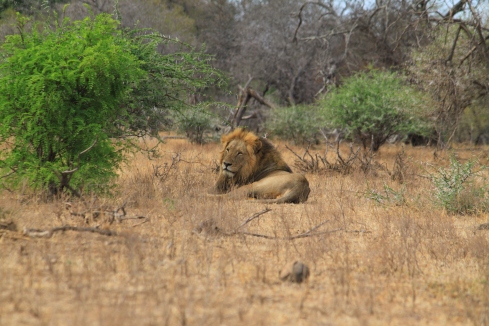
Also, I really do not recognise any of the trees here, except for the mopane, but that one doesn’t really count cause it’s too easy. But honestly, I couldn’t care less and feel no pressure to try harder.
Furthermore, I’m soon to find out that the elephants in Kruger are definitely less docile than the ones in S&L. They make their point on my first encounter with a herd when one of the younger females forces me to back up seemingly with a little grin on her face, as if she’s saying “nice try dude”.
All in all Kruger is way more spectacular than I imagined or remember from my last visit 20 years ago. I’m spending most nights in small satellite camps, keeping a respectable distance from the more massive camps. And even though some of the camp sites were fully booked, it doesn’t feel crowded at all.
And the wildlife is actually quite spectacular! The second morning I see a group of 3 female lions with cubs abandon a (mostly eaten) prey to 26 (!) black-backed jackals and 7 spotted hyenas, with buffalo, tsessebe and a fearless honey badger passing by.
I also, admittedly out of sense of boredom, randomly decide to follow a pair of jackal that I see around an otherwise unvisited waterhole, only to find them going back to their den, enthusiastically greeted by their three young in arrival. Such a cool sight!
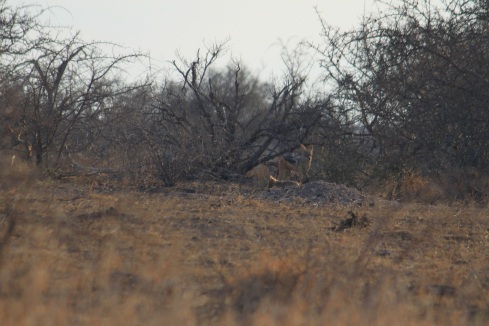
And otherwise it’s still the small things that make my heart skip a few beats.. The sound of a tree squirrel marking his territory from a nearby adversary, the occasional leopard tortoises crossing the road, the pearl-spotted owlet being mobbed by a grey headed bushshrike, the lesser bushbaby jumping around the trees at Crocodile Bridge Camp, or just the simple beauty of your average impala or giraffe.
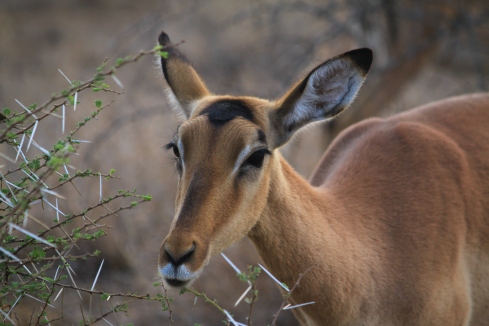 Luckily I’m still super excited when someone points out the white rhino walking in the far distance with its young. Clearly, I’m not completely lost… (yet)
Luckily I’m still super excited when someone points out the white rhino walking in the far distance with its young. Clearly, I’m not completely lost… (yet)
** sorry camera battery had died, no rhino pics **

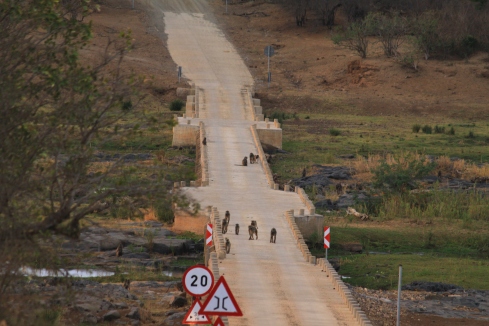
The other day I saw a video of Snoop Dogg recieving a star on Hollywood Walk of Fame and thanking the person he should thank for his result in life. Not a god, not his mother.. but himself.
I wanna thank ME
I wanna thank ME for believing in me
I wanna thank ME for doing all this hard work
I wanna thank ME for never quitting*
were amongst the things he thanked himself for.
The clip is used as motivational speech, meant to inspire others to create their own reality, a reality they can thank themselves for.
After the course, our reality is that Susanna and Niklas fly home straight out of camp and Terrence will be going back to work within days. Man, am I super happy that I don’t have to go back to normal life after this. Having spent two months in a tent, in a camp, in nature, it must be extremely weird to go back to European civilisation.
But that’s not me though. I get to spend another three weeks in Africa before flying out. My plan is to see a bit more of Zimbabwe, as I imagine it must be beautiful apart from its obvious flaws. It doesn’t exactly work out that way though. First of all, Victoria Falls is super expensive. Any activity will set you back tens of dollars, and even accomodation has western prices.. although admittedly standards are quite high as well. And then there is the economic crisis in the country. There’s hardly any fuel in Vic Falls, so my plan to rent a car and go to Hwange isn’t going to work out. There’s no money either, or at least no US dollars that most shops prefer. It even comes to a point where I’m in a restaurant in Bulawajo with the waiter telling me that my burger will cost me 9 USD when I pay in actual USD, 18 USD when I pay in Zimbabwean Bond dollar and 27 USD when I pay with (credit) card. This monetary system quickly drains me of my last remaining US dollars that I have left, and I’m barely able to buy a bus ticket to South Africa with my remaining money.
There is one thing I need to do first though. It has been an amazing coincidence that I ended up in Victoria Falls, 5 minutes from the Zambezi river, thé river of my dreams. A river I never dared dream of paddling, and now it is right here, quietly calling out my name.. I purposely did not bring any kayak gear, as I did not deem myself worthy of paddling this infamous river. But now everyone is trying to convince me to just do it. And it makes some sence, after all: it ís right here.
Wisely enough the rafting companies will not just let me join them. The river is too big for that, and consequences might be severe. One company will allow me to paddle part of the river though, as part of a rafting trip. The price is pretty steep at $120 though and for a few days I ponder on it, even considering crossing the border into Zambia to paddle the same river but entering from the other bank. But a quick internet search unveils that rafting from there is even more expensive at $160 for only 3-4 hours. So I stay in Zimbabwe debating what to do. It would be a dream come true though and really, this internal debate is just for show. I’ve already decided to do it long ago.
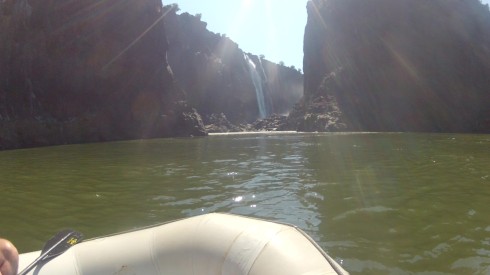
Just below Vic Falls
We start off just below the Victoria Falls, once the main destination of a dream of mine, and now the starting point of another. And the river is b.i.g.! Man, am I happy that I am not paddling the first couple of rapids. They are way too big for me. Even in the raft they turn out to be a challenge. I get catapulted into the water 3 or 4 times.. and admittedly, swimming in these turbulent waters is not exactly fun. Then, right before rapid 13, the guys tell me to switch places with one of the safety kayakers. The kayak does not have foot rests nor a back rest, but it will have to do.
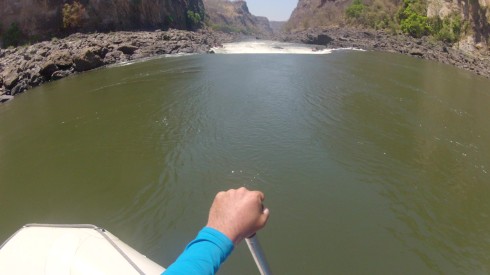
We kinda take somewhat easier lines, but still, these rapids are BIG. Running rapid 18 I decide to go for the middle line instead of the chicken line on the left. It is a huge rush of adrenaline, and when I make it through I go into 2-minute long tantrem-like sequence of excitement fueled screams.
It is bizarre… in just over a year I have paddled 3 rivers I never thought I’d be able to paddle. First, there was the White Nile in Uganda a year ago, which I got to paddle for about a month. Then there was Futaleufu earlier this year, a river I had dreamt of for about 10 years. And as if that wasn’t enough, I freaking get to paddle the mighty Zambezi. Admittedly, these weren’t the most formidable rapids of the river, but fuck it, I’m here and I’m paddling this river. For me, it will do!!
Somehow quiting my job, ending up in a Santiago hostel I never intended to go to (another hostel messed up my booking), meeting a French kayakker there who would later invite me to paddle with him in Peru, postponing my field guide course to do just that.. somehow all that made me end up here in Zimbabwe, giving me the opportunity to paddle the mighty Zambezi and making my dream come true. I may not have a star on the Hollywood Walk of Fame, but nevertheless I am a blessed man.
And admittedly, like Snoop Dogg, at times I am tempted to think it is ME who is to thank for all this fortune…. but considering the sequence of events there must have been at least a hint of serendipity here!
(* note: Snoop Dogg also thanks himself for having no days off, but clearly that wasn’t usefull for my story here, as this in no way applies to me)
It’s not entirely back to school this week though, as this week is all about bush walks. Abraham has returned and he takes us out two walks daily. We’re all still a bit in holiday-mode and also very happy that someone else is doing the guiding now. Personally though, I’m not a big fan of bush walks. All in all, you don’t get to see that many things (at least not here in Stanley & Livingstone) or maybe it’s just that we have a lot, a lot!, of little stops to check things out and that makes the walks pretty slowgoing and undynamic. That being said, we spend one morning tracking baboons and have some reasonably close encounters with black rhino and a herd of buffalo on other walks, which is pretty cool.
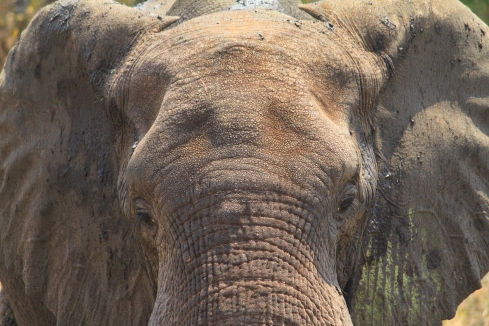
Slowly but surely we need to start prepairing for our exams too. My focus shifts almost entirely to bird calls and bird pictures. Every day I spend at least 30 minutes listening to bird calls on my phone. In the mean time, temperatures have been crazy high. Generally, at 10 o’clock it will already be 30+ degrees, to eventually reach highs of up to 38,5 Celcius. At some point it is only 34 and we all feel a bit chilly. Needless to say, these are not temperatures that are conducive to studying hard.
In week 7 it is back to normal. We have our last practice drives and once again David raises the stakes. Not only do we now need to recognise the trees and know at least one practical, medicinal and cultural use. Now we need to connect an arthropod to most of the trees. For instance, a striped policeman butterfly will mainly lay it’s eggs on the leaves of a red bushwillow. So when talking about a red bushwillow, add value by mentioning the striped policeman butterfly. Also birds, add even more value to birds. What type of nests do they have: groundnest, floating nest, cupnest, a nest dug in a riverbank, or a unusual nest (official terminology). Or any specifics on feeding methods, or breeding methods or.. whatever. Add value.. it is more of the same, but mainly more.
Luckily I’ve overcome the sence of resistance I felt a few weeks ago, and decide to just do whatever is needed to pass this course. I don’t really know what it is though, what makes me want to want this. It might well be an ego-thing, as in that I don’t want to give up, or that I like the idea of being able to say that I’m a guide. Or maybe it is the fact that I would actually like to have this as a carriere option, however unlikely it may be. I don’t know what it is. But I know that I started this and now I want to finish it.
So this time, on my drives I pick up that grass, I stop for that tree, I elaborate on that bird. But I do it on my terms. I only talk about those things that are truly interesting to me personally, and steer well away from the standard topics we’ve heard so many times before, like the mopane tree and its butterfly shaped leaves. So I talk about how basalt rock can be found on the moon, how the African hoepoe was deemed an impure bird in the Old Testament, and how the wild dagga plant doesn’t have the same effects of the Dutch marihuana plant but is nevertheless enjoyed for its sugar-laden bulbs. And you know what?! I actually like it. I myself am rather shocked, but I actually enjoy telling these little facts, sharing these mini-stories. I’ve been having similar experiences with the night sky and the stars. For months I’ve been staring up to the South American skies, identifying the bright bright stars, figuring out the constellations, while at the same time wondering what to do with that knowledge. Turns out there is tons and tons of Greek and Roman mythology connected to these constellations, all being mini-stories of their own. And I find that I really enjoy sharing those stories with my fellow students.. mostly since I am the only one who is remotely interested in the celestial world.
And then it’s week 8. Or rather, the end of week 7. The exams are coming so Karsten decides it’s time for him to bail. He’s not doing the exams, and has no intention of hanging around either. Instead, he has changed his plans and is heading to Kruger Park for a week of guided walks holiday-style. The man is certainly doing something right!
First, we need to finish our research assignment. I’ve already forgotten what the exact assignment was, but we needed to show that we know something about the historical and cultural heritage of our area of operation. Again, none of us understands what is expected of us, and somehow David is incapable of adequately explain it to us. It’s just vaguery we get from him. So in return, all of us hand in some vague nonsense about the tribes that lived in Zimbabwe, and the cultural value of Victoria Falls and/or the ruins of Zimbabwe. We all pass.
Then, those of us that remain (Susanna, Terrence, Niklas and me) start off with a prelimenary test, to make sure we are ready for the real FGASA exam. It’s not an official examination, but a way for our training provider to prove that we master everything we need to know. It covers rather stupid questions about soil types, and weather systems, and blablabla. David is quick to look over our papers and then comes back to us with “homework”. It is the dumbest thing ever. At question 13 he told us not to talk about winds, and then he tells me I need to add something about winds. His explanations are so confusing, none of us really know what he’s expecting. So we wait until he leaves for a little trip to town and then copy each others work. Done.
Then it’s Saturday evening, the evening we have been dreading for a while now. It is time for our first real and official exams. We get 20 bird pictures (out of 90) and 20 bird calls (out of 90) to identify, 6 Frog/toad calls (out of 12), 6 frog/toad pictures (out of 12), 14 reptile pictures (out of 27). And we need to be precise: it’s not just hornbill, or yellow-billed hornbill.. no, it needs to be the full name: southern yellow-billed hornbill.
A slight panic breaks out when I don’t recognise the first picture, but in the end all is well: I freaking nail it. Mannn, all the time and energy I’ve invested in this pays off, halleluya! Niklas does well too, whereas Susanna and Terrence will have to do a couple of reassessments.
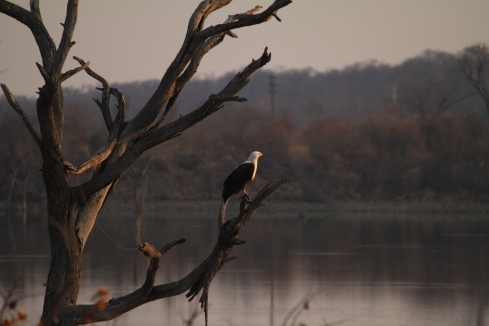 Then Sunday is study day. Only study study study. From early morning to evening. Our camp “manager” Vanessa has told us 80% of the exam will consist of questions from the workbook, so we decide to work only on this. One of our study books, the one that covers the actual how-to-do-guiding part, I don’t even touch. In the afternoon Niklas, Terrence and I sit together to go through all the questions in the workbook. I feel quite well prepared, but Terrence realises he needs to step it up. It will be an all-nighter for him.
Then Sunday is study day. Only study study study. From early morning to evening. Our camp “manager” Vanessa has told us 80% of the exam will consist of questions from the workbook, so we decide to work only on this. One of our study books, the one that covers the actual how-to-do-guiding part, I don’t even touch. In the afternoon Niklas, Terrence and I sit together to go through all the questions in the workbook. I feel quite well prepared, but Terrence realises he needs to step it up. It will be an all-nighter for him.
To beat the heat we start early on Monday: at 7am David hands out the papers. I do a quick scan of the questions before I really start filling in the answers (this is how I used to do in high school as well, back in the days) and my confidence goes up. I can do this. Three hours later it’s done and I feel relieved: I know I’ve got this.
In the end the exam turns out to be waaaaaay easier than it could have been, and I kinda hate David for not giving us some more insight, some more reassurance. Especially Susanna has had a rough couple of days leading up to the exams and eventually was only persuaded last minute to go through with them. This could have been handled in a much better way.. but even without that, she passes with ease.
We’re all super excited. And super nervous at the same time. One more day. One more test. All that is left is our final game drive.
I get to go second, with an afternoon drive. That last bit kinda sucks, since it is so super hot during the afternoon with so little shade. It’s not very conducive to a pleasant drive. But I do not have another option than to occasionally stop for a tree, or some stupid grass. It’s definitely not my best drive and the blazing sun and lack of shade make for a louzy combination. We do end up in the middle of a grazing herd of buffalo, which is pretty sweet, and finish off with a nice sighting of a couple of lion… a moment where I realise I may actually know more about sawtooth lovegrass than about lions.
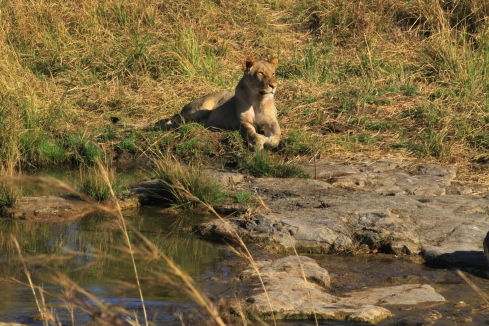
Three hours later we return to our camp, where I park the car next to the kitchen, thank my guests for their contribution and ask for feedback. And then David gives me the final words: Jeroen, you passed! Damn..
I AM A SAFARI GUIDE!!!!!!
David being David he cannot help himself however, and he lashes out to Niklas and Terrence for not taking off their caps while giving me feedback. It’s a cultural thing apparently, in South Africa it’s a sign of disrespect. But we are not South Africans, Nicky and T. are my buddies, and the words they spoke were more than respectful, and I myself have taken no offense. It’s a bizar move of David and a bit of a bummer for me. I should be happy now, but my last drive ends on a bit of a negative.
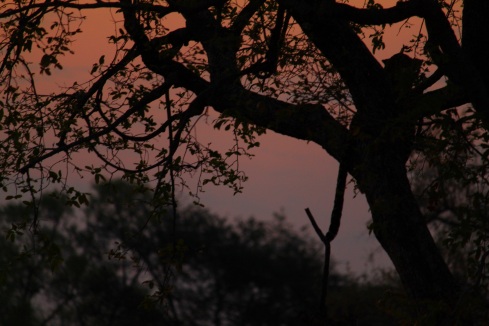 The next day it’s D-Day for Niklas and Terrence. Niklas freaking nails it, so much so that I even feel bad for Terrence for having to follow after him. But it turns out Terrence has held something up his sleaves. Being a native Zimbabwean and with his granddad and dad both being guides, Terrence has by far the most knowledge of all the students, but somehow it hasn’t really come out during his practice drives. But clearly he was saving the best for last, ‘cause he knocks it out of the park. We finish our course with the best drive any of us has done during these 8 weeks of training. Really really cool!
The next day it’s D-Day for Niklas and Terrence. Niklas freaking nails it, so much so that I even feel bad for Terrence for having to follow after him. But it turns out Terrence has held something up his sleaves. Being a native Zimbabwean and with his granddad and dad both being guides, Terrence has by far the most knowledge of all the students, but somehow it hasn’t really come out during his practice drives. But clearly he was saving the best for last, ‘cause he knocks it out of the park. We finish our course with the best drive any of us has done during these 8 weeks of training. Really really cool!
And for me personally, it was one of the best days as well. Finally, I am able to relax. I can just sit in the car, and enjoy it. Without listening to instructions, without taking notes. Just sitting and watching. It is so cool. At some point Terrence talks about the importance of rhino conservation and mentions the few remaining rhinos in Asia in passing. It sends me off into my own world…. I’ve been there, I’ve seen these rhinos in a park in the south of Sumatra. And as I remember that, I realise how blessed I am, blessed to be able to travel to beautiful places, blessed to be here, blessed to meet amazing people, blessed to be doing what I’m doing. The course is all but over, and I finally experience a moment of pure joy.
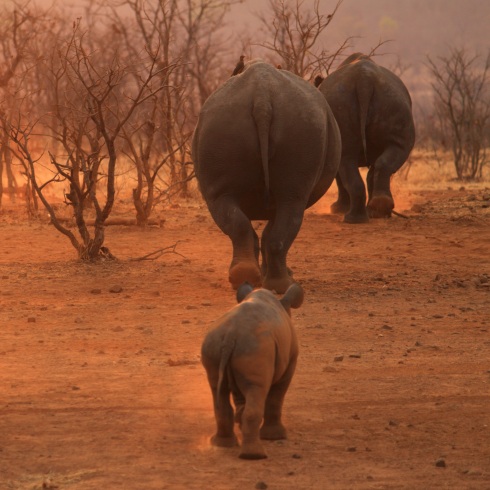
Because of visa regulations we cannot stay in Zimbabwe for more than 30 days, and therefore we need to leave the country temporarily. We head across the border with Botswana and spend four days in Chobe National Park. And mannn, is this a welcome distraction. Everyone instantly goes into holiday mode. No game drives, no lectures, no notes. Now, thís is a holiday!!
We are taken on a river cruise and then on a couple of game drives. IT. IS. AMA. ZING! Stanley & Livingstone is a rather small reserve and since it is fenced-off (because of the black rhinos) animal diversity and numbers are somewhat low. Chobe is a whole different story though. We see more than a thousand elephants (sorry, we lost count), hundreds of buffalo, tons of impala, dozens of giraf and lots of lions with cubs. And we sleep in tented camps with hyena visiting and elephants passing by in the not-so-distance. It is truly spectacular.
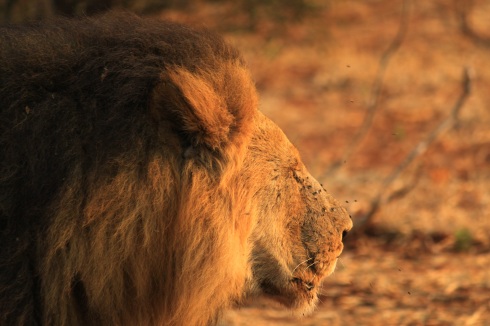
We spend the nights in unfenced camp sites, with elephants wandering past during the day and lion and hyena passing through during the night.
Our driver/guide Jenson is amazing. He speeds like a maniac, drives super close up to elephants, doesn’t really ask whether we have any special interests, makes his own plan for the day without informing us. He certainly would fail miserably for our course… but he does what he is supposed to do: he shows us the animals.
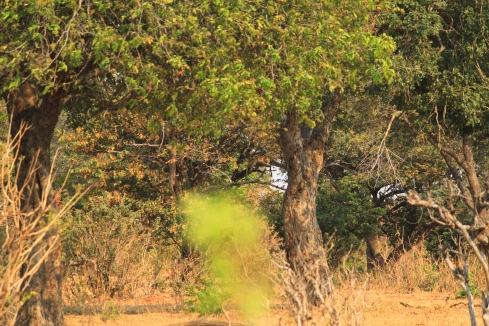
Spot the leopard!!
Being a former hunter, he more than qualifies as a superb tracker. After one morning drive he even predicts that we might see a lioness move her cubs during the evening drive..and then we do!! I understand why we need to go through all the theory and all the etiquette etc etc, but once you work in a place like Chobe, it really doesn’t seem to matter that much.
Every now and then Dave goes into instructor-mode, but as long as you’re not sitting directly behind him, it’s a super easy to simply ignore him.
We spend another couple of days visiting Victoria Waterfalls and the Zambezi National Park. The falls once again are spectacular. On my previous visit I only got to see them from the Zambian side, and I have to say: the Zimbabwean side is waaaaayyy better.
Zambezi National Park however is not that interesting to be honest. At least when we are there, hardly any animals are to be found. BUT, we do get to paddle down the Zambezi river in inflatable kayaks amidst hippos and crocodiles. As a kayaker paddling on the mighty Zambezi is a bit of a dream come true, even though this is not the part with all the big rapids. So I feel completely in my element here. The hippos are a bit of a nuisance though. Man, are they grumpy little bastards. Yeah, we definitely do not feel like getting anywhere close to them.
Then, in week 6, it’s back to business again. Back to school…

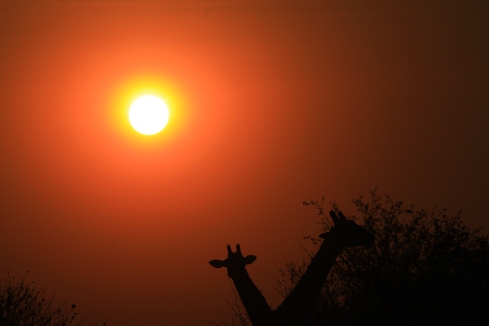
Two weeks after I had quit my job in October 2017, my boss sat down with me to check whether I was really serious. So I told him about the intense feeling of liberation that I had felt ever since making that decision, and how somewhat overwhelming it was to think about all the options I had. There had definitely been that sense of I can do anything I want now, the world is my oyster and the sky is the limit. So I mentioned to him that I could even become a safari guide, to which he laughed at bit. To be honest, I don’t think that it was an ill-intended laugh, but it did come across as a bit of a smirk. As if he thought that it was the stupidest idea he had ever heard. And that was the moment I knew: I am going to be a safari guide. Admittedly, doing this out of spite is probably not the best of reasons, but hey, I’m only human.. I have my (very few) weaknesses.
Turns out, it takes 55 days to become a safari guide, or field guide as the official title reads. At least, it takes 55 days if you’re rich, not from Africa and don’t know anything about African nature (you may think you do, but you don’t).
It’s mid-August 2018 and together with my fellow students Karsten, Suzanne, Niklas (all German) and Terrence (Zimbabwe) we set up camp in the Stanley & Livingstone Game Reserve just south of Victoria Falls, Zimbabwe. Stanley & Livingstone is one of very few places where black rhino are still.. well, alive, I guess and we move into the unfenced Mopani camp, which we will share with the anti-poaching crew.
Each of us gets his/her own tent to call his/her home for the next two months and otherwise there’s not much. Sure, there’s a communal area, i.e. dining table with chairs, a makeshift gym consisting of a pull up bar and a fire pit. Otherwise, it’s just nature.
Now, this doesn’t mean we’re roughing it though. The tents are larger than the back of my Montero, and during the entire stay our chef Senzo cooks the most tasteful meals I’ve ever had. And I am a very picky eater!
It doesn’t take long, however, for us to realise that this is not going to be a long holiday. Upon our arrival in camp, our instructor Dave gives us a brief description of what we can expect. During the next 8 weeks, this will be the daily program:
Except for Sundays; this generally is a day where we can sleep late and go to a nearby lodge to enjoy the pool/wifi.. I mean to study.
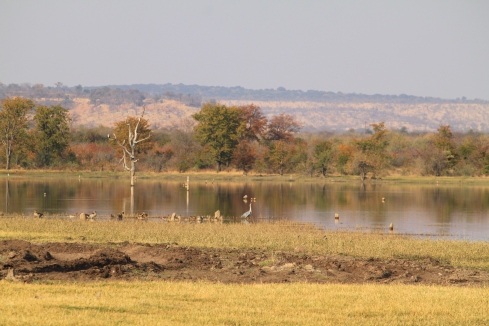 At the end of these eight weeks, we will be doing an official theoretical exam, and we’ll be guiding a game drive that needs to be informative and entertaining. But, that’s not all: there will also be a test on 90 birds (both pictures and sounds), 27 reptiles (pictures) and 12 amphibians (pictures and sounds). AND in the mean time we will have to show proficiency in knowledge of 40 trees, 28 animal alarm calls, 20 animal tracks, 12 animal dung, 10 grasses & wild flowers, 9 types of soil, 8 constellations, 5 deep space objects, etc… Oh yeah, and then there’s the animals.. people who go on a safari generally want to hear something about animals as well.
At the end of these eight weeks, we will be doing an official theoretical exam, and we’ll be guiding a game drive that needs to be informative and entertaining. But, that’s not all: there will also be a test on 90 birds (both pictures and sounds), 27 reptiles (pictures) and 12 amphibians (pictures and sounds). AND in the mean time we will have to show proficiency in knowledge of 40 trees, 28 animal alarm calls, 20 animal tracks, 12 animal dung, 10 grasses & wild flowers, 9 types of soil, 8 constellations, 5 deep space objects, etc… Oh yeah, and then there’s the animals.. people who go on a safari generally want to hear something about animals as well.
Now, as if that isn’t daunting enough, there will also be weekly tests, so-called Field Observations, to test us on what we’ve covered up to that point. And we have a workbook to complete weekly AND we have a study assignment to be completed before the end of the course.
Yep… that certainly does NOT sound like a holiday to me?!
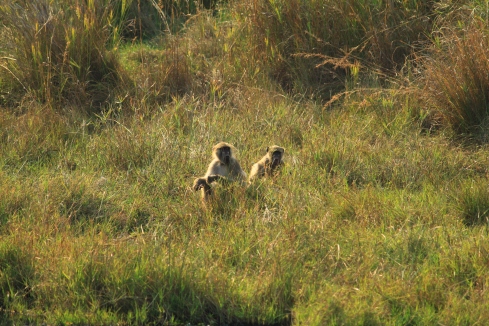
We start off with a day of nature walks with local guide Abraham, and it quickly becomes apparent that we will need to takes notes.. lots of notes. Then, the next days Dave takes us on game drives through the park and what we experience here can only be described as a bombardment of information. He picks up a rock and tells us it’s basalt, then he picks up another rock and tells us it’s clearly a different type of rock called ferricrete, and then another one: dolerite. We hear birds, so he stops and tells us that it’s a lilac-breasted roller or a African wattled lapwing or a Southern ground hornbill.
Then we’ll stop for a tree and he’ll point out the leaf structure, and how this differs amongst trees.

Notes to remember leaf structure
He hardly speaks about animals, but even if he does, it rarely is something I’ve heard before. It’s all new, it’s continuous, it’s relentless. Luckily, I’m not alone: all of us are quite shocked by what is happening. This is not what we were expecting.
Then, in the second week, Dave ups the ante. Now, he won’t be driving anymore: we will. We, the students, will take turns in guiding our little group through the park. And we’re supposed to stop and talk about soil, trees, birds, animals. Even though we feel we haven’t learned anything yet.
This definitely adds pressure to us, because even though everyone knows this is just practice, one generally wants to do well in these kinds of situations. You don’t want to take people out for a boring drive. Of course, Dave doesn’t stop teaching (or instructing would be a better word probably).. oh noooo, he keeps bombarding us with information.
Personally I kinda luck out on my first two drives. On my first drive there’s an elephant that approaches the car to about two meters, and on my second drive a black rhino comes even closer and almost scratches the car’s paint with its cut-off horn. This is pretty cool stuff, so everyone is excited and happy.
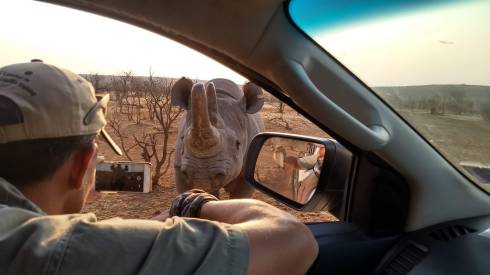
An inquisitive black rhino coming in for a closer look
Niklas has one of the easiest game drives ever. He happens to find two lions mating. Pretty darn cool.. and as a guide it’s easy: you let nature do the talking.
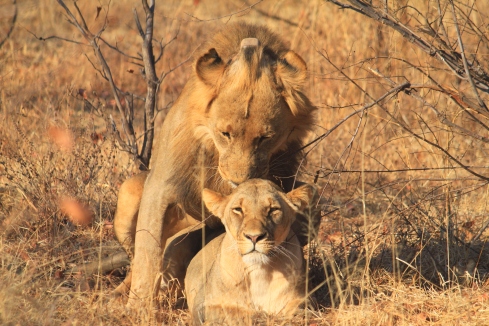
Karsten is not that lucky though and has some rather uneventful drives; furthermore, he clearly struggles with keeping up with all the information that is coming his way. At the end of the week, after a loooong phone call with his wife, he throws in the towel; he won’t be doing the test. It is a magical move on his behalf. No more compulsory lectures for him, no more pre-game-drive-stress, no more bird calls to learns, no more trees to recognise. From that moment onwards he just casually sits in the back of the car, listens to whatever he wants to hear, and otherwise simply relaxes. As for the others, we understand his move, we envy him for making the decision, but our egos keep us from what would feel like giving up.
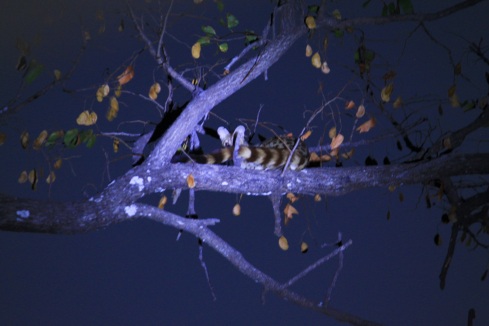
My first ever (large spotted) genet!
By the third week, the ante is upped again. We’ve been introduced to 30 trees within 10 days, but already even recognising and identifying a tree isn’t enough anymore. Dave makes it quite clear that being a guide is all about adding value: you don’t just point out an animal.. no, you add value by telling something interesting about the animal for example whether it’s territorial, what it eats etc. And this isn’t limited to animals. Same goes for trees: we will need to add value for example by explaining the cultural significance, be it as a medicine, a practical use or some mystical belief.
For instance, the mopani tree. Its leaves resemble a butterfly, which in Shona language is mopani. When crushed the leaves smell somewhat like turpentine. Its seeds become sticky when rubbed, so as guides we would add value to our clients’ safari experience by picking some leaves or seeds and letting them touch or smell them. And then add even extra value by explaining how local people use the bark to stop diarrhoea, or the leaves to stop a little cut from bleeding. Honestly, I find this super interesting. I find that I really enjoy these little “stories”, whether it’s about birds, trees or stars. But obviously, I’m still struggling with the first and main challenge: to identify that bird or tree.
In the meantime, we also have these “lectures”. These cover the theory behind subjects like geology, astronomy, weather/climate/clouds, conservation management and even historical human habitation. It really is as if we’re back in school. But honestly the content of these lectures is quite useless. They consist of powerpoint slides that Dave just races through as if it’s common knowledge. Obviously, in theory we should read the relevant chapters of our study books beforehand, but after two weeks of trying I give up.. there simply is no time.
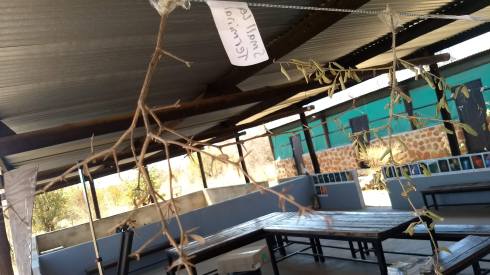
Lecture room
It was probably week four when my resilience started to break. Obviously we’re all learning the exact same things and we’re always the same group going out. So on our game drives we’re basically repeating what the other students have said yesterday or even a few hours ago. And to me it is very very difficult to pretend I didn’t hear all that, to pretend that this isn’t the same group of people all the time. So I quietly refuse to be the fourth person to make a butterfly out of a mopani tree leaf, I simply won’t. Nor can I be bothered to pluck some yellow thatching grass to explain for the gazillionth time that this grass is used for thatching roofs. Really man, who goes on a safari and wants to hear about that. People want to see lion and elephant and leopard.. and I feel we’re learning nothing about them.
As expected, this doesn’t earn me very positive feedback from Dave. And he clearly has no intention of discussing my reservations. These tasks are what needs to be done in order to become a guide.. so deal with it. Now… I think I can safely say that I am not a person who thrives when confronted with that style of “leadership”.
I remember how many many years ago my late grandfather was given a home-trainer-cycle-thing as a birthday present. My dad told him not to go too crazy on it, which prompted my granddad to immediately jump on the bike and show us that he was fit. For barely a minute he cycled like a maniac until he was completely out of breath. But not for a second did he feel that he had actually proven my dad right. It probably wasn’t even about that. If anything, it was about him making the point nobody should tell him how to do things. And I think I am at that point now. Like my grandfather, I don’t do things your way; I do things my way!
Luckily, at this point it is time for a little break in our busy schedule…
